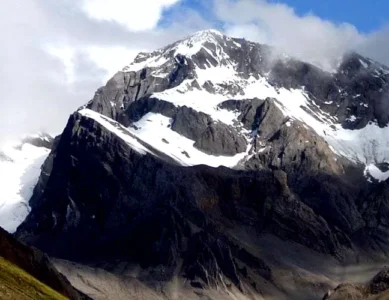Nestled amidst the breathtaking peaks of the Kumaon Himalayas, Adi Kailash and Om Parvat offer a unique blend of spiritual significance, cultural immersion, and natural splendor. This lesser-known pilgrimage destination attracts trekkers and devotees seeking adventure, inner peace, and a connection to the divine.
Unveiling the Mystical Aura:
- Adi Kailash: Known as the “mini Kailash,” it’s revered as the replica of Mount Kailash, abode of Lord Shiva. The circumambulation (parikrama) around the sacred peak holds immense spiritual importance for Hindus.
- Om Parvat: Named after its resemblance to the sacred “Om” symbol, this peak inspires awe and serenity. It’s considered a powerful meditation site and believed to bring spiritual growth.
Planning Your Pilgrimage:
- Dates: The ideal season is between March and October, offering pleasant weather and clear skies. Avoid monsoon season (July-August) due to landslides and treacherous treks.
- Registration: Not mandatory, but online registration through Kumaon Mandal Vikas Nigam (<invalid URL removed>: <invalid URL removed>) is recommended for efficient darshan and access to specific facilities.
- Travel Options:
- By Air: Fly to Pantnagar Airport (35 km from Nainital, the starting point) and then take a taxi or cab.
- By Train: Take a train to Kathgodam (35 km from Nainital) and then take a taxi or cab.
- By Road: Well-maintained roads connect to Nainital from major cities like Delhi and Dehradun. Consider renting a car or opting for public buses or shared taxis.
Inside the Journey:
- Non-Hindus: Only Hindus can enter the main temple complex at Adi Kailash. Non-Hindus can still appreciate the natural beauty and enjoy the surrounding area.
- Dress Code: Dress modestly and respectfully. Cover shoulders and knees. Remove shoes before entering temple areas.
- Travel Tips:
- Physical Fitness: The parikrama involves moderate trekking. Prepare with good shoes and be mindful of the altitude.
- Essential Gear: Pack comfortable clothing, rain gear, sunscreen, sunglasses, a hat, a first-aid kit, and sufficient water.
- Local Guides: Consider hiring local guides for deeper insights into rituals, cultural significance, and navigating the terrain.
Minimum Duration:
Allocate 3-4 days for the pilgrimage, including travel time and exploring the surrounding area. Consider an additional day for a more leisurely experience.
Weather:
Expect varying temperatures with warm days and cool evenings, especially during peak season. The monsoon season brings rain and humidity. Pack accordingly with breathable clothing and rain gear.
Facilities:
- Basic amenities like food stalls, cloakrooms, and restrooms are available outside the main temple complex.
- Pre-book accommodation in Nainital, especially during peak season. Consider guesthouses near the starting point for convenient access.
Beyond the Pilgrimage:
- Explore the beauty of Nainital: Embark on a boat ride on Naini Lake, visit scenic viewpoints like Naina Peak and Cheena Peak, or delve into the vibrant Tibetan markets.
- Discover other nearby attractions: Take a day trip to Ranikhet, a hill station known for its scenic beauty, or explore the wildlife sanctuary at Corbett National Park.
Start Your Himalayan Adventure Today:
A journey to Adi Kailash and Om Parvat is more than just a pilgrimage; it’s a chance to connect with nature, immerse yourself in local culture, and embark on a path of self-discovery. With careful planning and a respectful approach, you can experience the transformative power of this sacred Himalayan destination.
Additional Tips:
- Be aware of monkeys around the temple complex and adhere to local warnings.
- Respect the local culture and traditions, and always ask permission before taking photographs.
- Leave no trace and practice responsible tourism to preserve the pristine beauty of the region.
Remember, while these destinations hold spiritual significance, prioritize responsible tourism and environmental sustainability during your pilgrimage.


